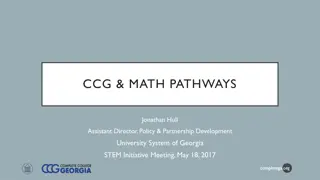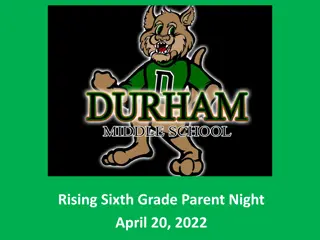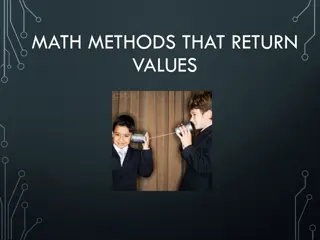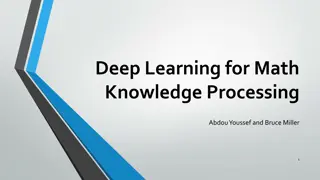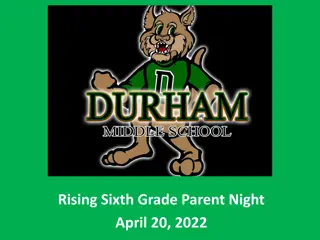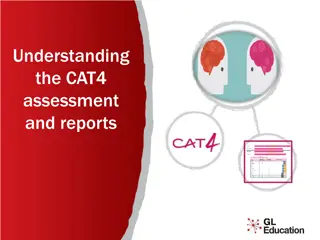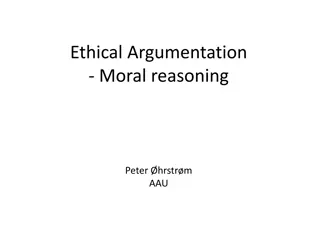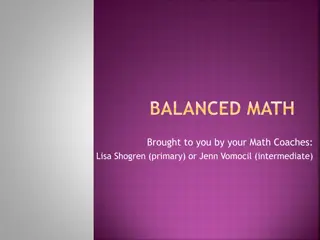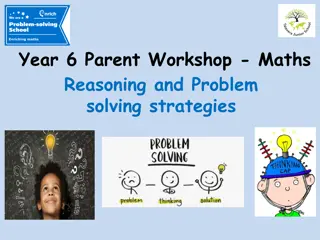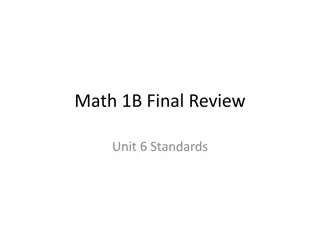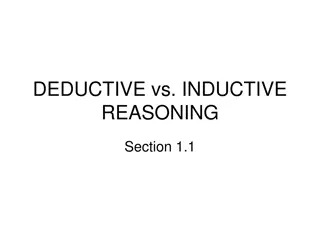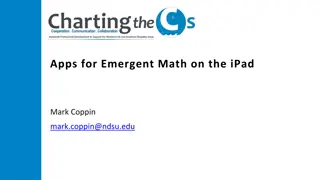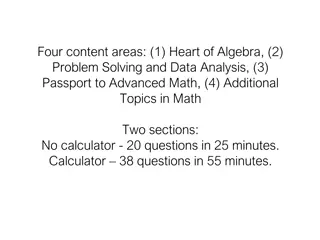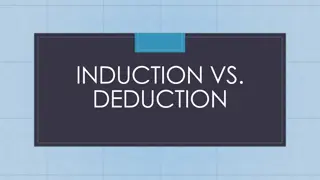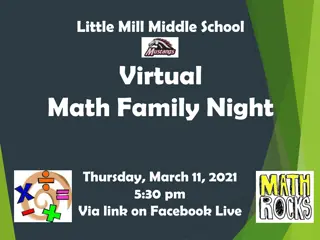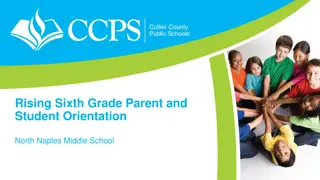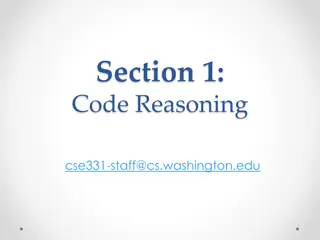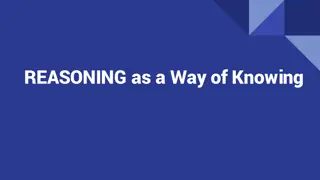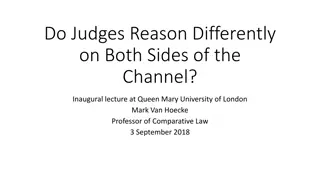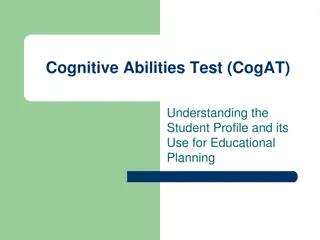Understanding Middle School Math Concepts: Analysis and Reasoning
This collection of images presents data related to middle school math concepts, including student performance, proficiency levels, and problem-solving scenarios. Explore subgroup data, parent education influences, and examples of mathematical reasoning to enhance your understanding of key concepts.
Download Presentation

Please find below an Image/Link to download the presentation.
The content on the website is provided AS IS for your information and personal use only. It may not be sold, licensed, or shared on other websites without obtaining consent from the author. Download presentation by click this link. If you encounter any issues during the download, it is possible that the publisher has removed the file from their server.
E N D
Presentation Transcript
Middle School Math Concepts: Is this reasonable? Esther Kim estherkim39@gmail.com
2011 API By Subgroup Subgroup API % of school population 100% 5% 2% 3% 84% 5% 69% All Students 736 596 963 895 730 784 726 African American Asian Filipino Hispanic White Socio-economically disadvantaged English Language Learners Students with Disabilities 668 19% 546
Percent of students scoring proficient or advanced Parent Education 6thgrade math 7thgrade Pre-algebra 8thgrade General Math 0% 8thgrade Algebra 1 Not a high school graduate High school graduate 8% 36% 35% 22% 49% 10% 34% Some college (includes AA degree) 24% 51% 25% 34% College graduate No students available in this category 39% 55% 44%
Over 50% or under 50%? Thumbs up if you think over 50% Thumbs down if you think under 50%
Over 50% or under 50%? 2 6 + 3 1 a) -3 c) 3 b) -2 d) 6
Over 50% or under 50%? 2 6 + 3 1 a) -3 c) 3 b) -2 d) 6
81.5% of the students responded correctly. 2 6 + 3 1 a) -3 c) 3 b) -2 d) 6
Over 50% or under 50%? 45% of 61.4 is a number between a) 3 and 30 b) 30 and 60 c) 60 and 240 d) 240 and 2800
Over 50% or under 50%? 45% of 61.4 is a number between a) 3 and 30 b) 30 and 60 c) 60 and 240 d) 240 and 2800
Approximately 20% of the students chose C or D. 45% of 61.4 is a number between a) 3 and 30 b) 30 and 60 c) 60 and 240 d) 240 and 2800 (0.45)(61.4)=27.63
Over 50% or under 50%? Which of the following is the largest? a) 3/4 c) 12/13 b) 6/7 d) 17/25
Over 50% or under 50%? Which of the following is the largest? a) 3/4 c) 12/13 b) 6/7 d) 17/25
31% of the students chose A. Which of the following is the largest? a) 3/4 c) 12/13 b) 6/7 d) 17/25
Over 50% or under 50%? (5/6)(30) a) 25 c) 150 b) 36 d) 156
70.8% of the students responded correctly. (5/6)(30) a) 25 c) 150 b) 36 d) 156
35.8% of the students responded correctly, and 32.5% of the students chose A. Order the following from least to greatest. 3/8, 1/3, 0.36, 0.39 a) 1/3, 0.36, 0.39, 3/8 3/8, 1/3 b) 0.36, 0.39, c) 1/3, 0.36, 3/8, 0.39 0.39, 1/3 d) 0.36, 3/8,
What has worked? Multiple Representations: One size does not fit all Pictures, Charts, Tables Verbal Algebraic Numeric Connecting concepts within lessons
Math 7 Subgroup % proficient or advanced (whole school) 29% % proficient or advanced (my students) 60% Black, not Latino Hispanic, not White Special Education 48% 64% 18% 36%
Need Challenge Possible Solution Teachers need training, spaces, and time to practice More opportunities for students to engage conceptually and build automaticity through relatable experiences or manipulatives Teachers did not learn this way Conceptual games and apps Availability and limitations of expertise Forums for professionals in different sectors to work together
Critical Concepts in Middle School Mathematics Mark Ellis CSU Fullerton mellis@fullerton.edu *Note: If you have an iPhone or Andriod phone with data access, please install the free Socrative Student Clicker app. My room # is 51016 Once you re in the room feel free to text in your thoughts and questions.
Shifting Focus Traditional U.S. How can I teach my kids to get the answer to this problem? Evaluate answers to determine proficiency. Common Core How can I use this problem to teach the mathematics of this unit? Examine responses to uncover student thinking and inform next steps pedagogically as all students move toward big idea(s) of a unit.
Reasoning about Division Divide 365/4 (by hand) using three methods.
Sense Making: Fraction Division 1. What question might this expression answer? 2. Find the quotient in a way that makes sense. 1 1 1 2 3 3. Share your reasoning with your neighbor(s) and/or send to Socrative #51016 What justifies your method? What prior knowledge is needed?
Learning Trajectories K -2 3 - 6 7 - 12 Rates, proportional and linear relationships Equal Partitioning Unitizing in base 10 and in measurement Rational number Fractions Number line in Quantity and measurement Properties of Operations Rational Expressions From Phil Daro, CMC-S
Two Big Ideas Equivalence Proportionality
Misconception about Equality If you learned to interpret the equal sign as an operation, 3 + 8 = 23 x 7 = how would you make sense of these? 4 x 97 = 4 (90 + 7) 2x 7 = x + 11
Euclids Algebra Challenge Model this geometrically, then with algebraic symbols. If a straight line segment be cut at random, the square on the whole is equal to the squares on the segments and twice the rectangle contained by the segments. (Euclid, Elements, II.4, 300 B.C.)
How Not to Learn Proportional Reasoning What is not developed when students learn this first? Why does this algorithm work?
Reasoning Proportionally John s mixture was 3 spoonfuls of sugar and 12 spoonfuls of lemon juice. Mary s mixture was 4 spoonfuls of sugar and 13 spoonfuls of lemon juice. Whose lemonade is sweeter, John s or Mary s? Or would they taste equally sweet? Eva and Alex want to paint the door of their garage. They mix 2 cans of white paint and 3 cans of black paint to get a particular shade of gray. They then add one more can of each color. Will the new shade of gray be lighter, darker, or the same?
Role of Technology Support and advance mathematical sense- making, reasoning, problem solving, and communication http://www.skill-guru.com/gmat/wp- content/uploads/2011/02/thinking-cap.gif (NCTM Position Statement, 2011) http://www.nctm.org/about/content.aspx?id=31734
Rhythm Wheel: Exploring Multiplicative Reasoning After 4 loops of this wheel: 1. How many individual sounds will be played? How do you know this? 2. How many times will the open hand drum sound be played? How do you know? 3. How many times more will the open hand drum sound be played than the slap drum sound? How do you know?
Rhythm Wheel (part 2) 1. How many loops would the 1st and 2nd wheels each need to make so they stop playing at the same time? Why? 2. If the 2nd wheel does 18 loops, how many loops will the 1st wheel need to make so it stops at the same time? 3. If the neck cowbell sound gets played 30 times, how many times will the open hand drum sound be played? Prove it! (Assume the wheels stop at the same time.) What if the neck is played x times?
Proportionality and Linear Functions If two quantities vary proportionally, that relationship can be represented as a linear function. If two quantities vary proportionally, the ratio of corresponding terms is constant, the constant ratio can be expressed in lowest terms (a composite unit) or as a unit amount, and the constant ratio is the slope of the related linear function. When you graph the terms of equal ratios as ordered pairs (first term, second term) and connect the points, the graph is a straight line.
CCSS-Math: Content Domains and Conceptual Categories K 1 2 3 4 5 6 7 8 HS Counting & Cardinality Ratios and Proportional Relationships Number and Operations in Base Ten Number & Quantity Number and Operations- Fractions The Number System Expressions and Equations Algebra Operations and Algebraic Thinking Functions Geometry Measurement and Data Statistics and Probability
Two Categories of Tools Communication & Collaboration Content Exploration
Resources Charles, R. (2005). Big Ideas and Understandings as the Foundation for Elementary and Middle School Mathematics. http://www.authenticeducation.org/bigideas/sample_units/math_samples/BigId eas_NCSM_Spr05v7.pdf Learning Progressions/Trajectories in Mathematics http://ime.math.arizona.edu/progressions/ http://www.turnonccmath.com/ http://www.cpre.org/images/stories/cpre_pdfs/learning%20trajectories%20in%20math_ccii%2 0report.pdf Math Reasoning Inventory, https://mathreasoninginventory.com/ Seigler, R. (2012). Knowledge of Fractions and Long Division Predicts Long- Term Math Success http://youtu.be/7YSj0mmjwBM and http://www.psychologicalscience.org/index.php/news/releases/knowledge-of- fractions-and-long-division-predicts-long-term-math-success.html To Half or Not lesson, http://www.pbs.org/teachers/mathline/lessonplans/pdf/esmp/half.pdf


